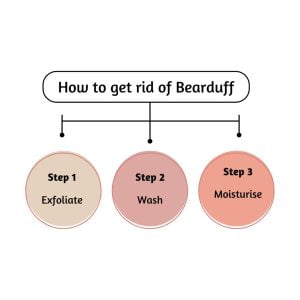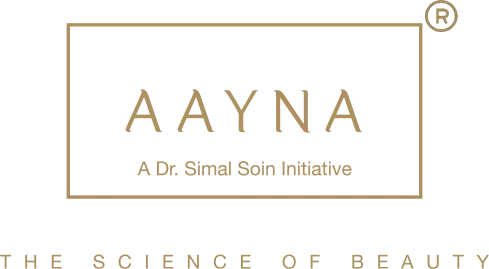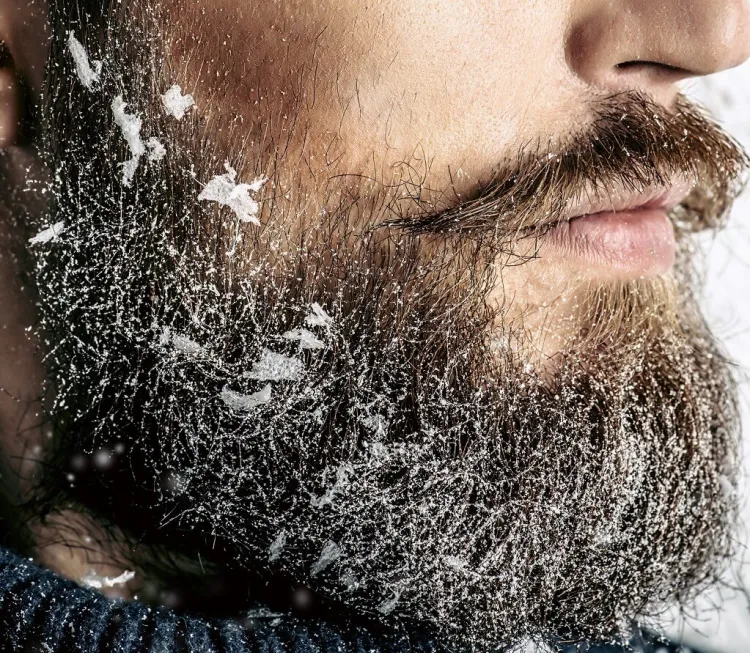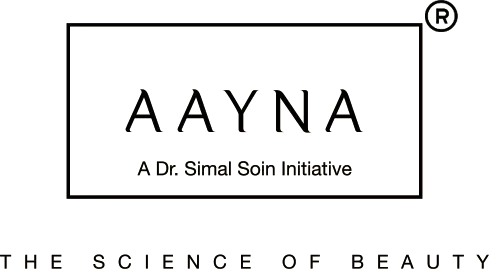In the ever-evolving world of men’s grooming, one topic that’s garnered significant attention is beard hygiene. The microbial mysteries lurking within beards, maintaining a clean and dandruff-free beard has become a top priority for many. Enter the realm of beard shampoos, conditioners, oils, and balms—a whole industry dedicated to keeping your facial fuzz in top shape.
Yes, beard dandruff is indeed a real thing, but fear not, for there are treatments aplenty to combat it. However, before you embark on a shopping spree for grooming products, let’s delve into the root causes of beard dandruff to gain a better understanding of what’s causing those pesky flakes to rain down on your chest. Here at AAYNA, our esteemed board-certified dermatologists have shed light on both the causes and treatment options for beard dandruff.
Understanding Beard Dandruff
What is Beard dandruff? Scientifically, it is known as seborrheic dermatitis, and is a condition that commonly affects the face and scalp. Symptoms include redness, flaking, and itching, with telltale signs of white flakes amidst red skin at the base of the beard.
Causes of Beard Dandruff
At the heart of beard dandruff lies a fungus called Malassezia globosa, thriving in oil-rich environments such as your scalp. This fungus breaks down oils in your sebaceous glands, leaving behind irritating oleic acid, resulting in dandruff. Additionally, rapid cell turnover can exacerbate the condition, creating an ideal breeding ground for dandruff-causing fungi.
Distinguishing Beard Dandruff
Not all flakes in your beard spell trouble. Dry skin can also lead to flaking, albeit with different characteristics. While dandruff flakes tend to be larger, greasier, and seemingly endless, flakes from dry skin are smaller, drier, and often accompanied by whitish or cracked skin.
Who’s Prone to Beard Dandruff?
If you’re no stranger to scalp dandruff, chances are you may also battle beard dandruff. Men, in particular, are more susceptible due to the responsiveness of their sebaceous glands to male hormones. Additionally, beard length plays a role, with longer beards providing a conducive environment for fungal growth and dandruff formation.
Read more:
Beard Dandruff Treatments
Effectively treating beard dandruff requires a comprehensive approach—exfoliating, washing, and hydrating/ moisturising.
 Step 1: Exfoliate Like a Pro
Step 1: Exfoliate Like a Pro
Let’s start by giving your beard the love it deserves with a gentle exfoliation session. Grab yourself a quality beard brush with soft bristles and let the magic begin. Not only does exfoliating help banish those pesky dead skin cells that love to cause trouble, but it also works wonders in distributing those natural oils from your skin, leaving your beard feeling softer and more manageable than ever before.
Step 2: Wash Away the Dandruff Blues
Now that your beard is prepped and primed, it’s time to give it a good ol’ wash. Treat it like the crown jewel it is by opting for a shampoo that means business. While your regular shampoo might do the trick, why not level up with a medicated formula specially designed to tackle dandruff head-on? Keep an eye out for powerhouse ingredients like pyrithione zinc, coal tar, selenium sulfide, or the ever-miraculous tea tree oil.
Massage that liquid gold into your beard, ensuring it reaches every nook and cranny of your skin. Let it work its magic for a minute or two before rinsing with lukewarm water—no scalding hot showers here, as they can do a number on your skin.
Note: Opt for a dandruff shampoo containing 1% ketoconazole. This antifungal ingredient kills fungus and yeast, preventing their return. While available over-the-counter, stronger doses may need a prescription.
Step 3: Nourish and Hydrate
Last but certainly not least, it’s time to lavish your beard with some much-needed hydration. Bid farewell to dry, flaky skin with the help of a trusty beard oil. Forget about greasy residue—this stuff is the real deal, leaving your beard feeling soft, supple, and downright luxurious. After cleansing, massage a few drops of oil into the skin beneath your beard, working your way down to the very tips. Start with a conservative amount, and if you feel like your beard is still thirsty for more, feel free to indulge—it’s all about finding the perfect balance for your mane.
When to Seek Professional Help
When your trusty at-home remedies just aren’t cutting it, it’s time to bring in the big guns. Here’s when to wave the white flag and seek help from a dermatologist:
- Stubborn Symptoms: If your beard is still playing host to those pesky flakes despite your best efforts, it’s time to call in the pros. Prescription treatments, from potent topicals to steroid drops, may be the secret sauce your beard needs.
Wondering if there’s more to your beard’s itchiness than meets the eye? Keep an eye out for these telltale signs of seborrheic dermatitis:
- Flaky Fallout: If your beard is snowing more than the North Pole, it might be a sign of seborrheic dermatitis.
- Greasy Patches: Is your skin feeling slicker than an oil spill? Greasy patches could be a red flag.
- Scale Showdown: White or yellow scales making a cameo on your beard? Time to investigate further.
- Seeing Red: Persistent redness on your skin could be a sign that something’s amiss.
- Itch to Scratch: If your beard has you scratching your head (literally), it might be more than just a passing annoyance.
Don’t hit the panic button just yet, but keep an eye out for these red flags that warrant immediate attention:
- Sleepless Nights: If your beard is causing you more distress than a late-night horror movie marathon, it’s time to seek help.
- Flakes of Shame: Are your beard flakes stealing the spotlight? Don’t suffer in silence—get help.
- Signs of Infection: If your skin is looking more angry than a toddler denied dessert, it’s time to call in reinforcements.
- DIY Disaster: When your home remedies feel as effective as a band-aid on a broken bone, it’s time for a professional opinion.
The Final Takeaway
Beard dandruff may be a common woe, but it’s nothing to be ashamed of. With a plethora of treatment options at your disposal, combating and preventing beard dandruff is entirely achievable. Establishing a consistent beard care routine is key to keeping those flakes at bay and maintaining a healthy, dandruff-free beard. So, embrace your facial fuzz and tackle beard dandruff head-on with confidence!
Frequently Asked Questions (FAQs)
Q. 1: What causes beard dandruff?
A. Beard dandruff, also known as “beardruff,” is often caused by a combination of dry skin, fungal overgrowth, and bacterial imbalance on the skin beneath the beard. Poor hygiene, harsh grooming products, and environmental factors can also contribute to its development.
Q 2. How do I know if I have beard dandruff or just dry skin?
A. Beard dandruff presents as white or yellow flakes in your beard and on your clothing. If you notice these flakes, along with itching or redness in the skin beneath your beard, it’s likely beard dandruff rather than just dry skin.
Q 3. Can beard dandruff be contagious?
A. No, beard dandruff itself is not contagious. It’s caused by a combination of factors related to skin health and hygiene, rather than a contagious pathogen.
Q 4. Is beard dandruff the same as scalp dandruff?
A. While they share similarities, beard dandruff and scalp dandruff can have different causes and require different treatment approaches. Scalp dandruff is typically caused by the overgrowth of a yeast called Malassezia, whereas beard dandruff can be influenced by factors like dry skin and bacterial imbalance.
Q 5. How often should I wash my beard to prevent dandruff?
A. Washing your beard 2-3 times a week with a gentle beard shampoo can help prevent dandruff without stripping away natural oils. Over-washing can dry out the skin and exacerbate dandruff.
Q 6. Can certain foods or lifestyle habits contribute to beard dandruff?
A. Yes, a poor diet, stress, lack of sleep, and smoking can all impact skin health, potentially exacerbating beard dandruff. Eating a balanced diet, managing stress, and adopting a healthy lifestyle can support overall skin health.
Q 7. Is it possible to have beard dandruff even if I don’t have a full beard?
A. Yes, beard dandruff can occur even in individuals with stubble or shorter facial hair. The skin beneath any length of facial hair can still become dry, irritated, and prone to dandruff.
Q 8. Are there any medical conditions that can cause or exacerbate beard dandruff?
A. Medical conditions like seborrheic dermatitis, eczema, psoriasis, and fungal infections can contribute to beard dandruff. If your dandruff persists despite using over-the-counter treatments, consult a dermatologist for further evaluation.
AAYNA SDA
C3/1, Safdarjung Developemnet Area, New Delhi- 110016
+91 704 229 7304 | +91 987 113 8222
AAYNA Khan Market
47, Middle Lane, Khan Market, Rabindra Nagar, Khan Market, New Delhi – 110003
+91 987 039 6667
AAYNA Gurgaon
Ground Floor, B-89, Sushant Lok Phase I, Sector 43, Gurugram, Haryana – 122002
+91 981 092 7946
AAYNA Ludhiana
7-E, 1st Floor, Sarabha Nagar, Ludhiana – 141001, Punjab
+91 857 500 6060



